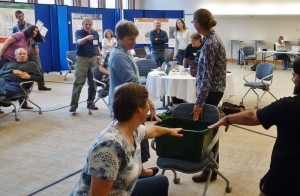Julia Morgan, Outgoing GeoPRISMS Chair (Rice University), and Members of GeoPRISMS Education Advisory Committee

Figure 1. MARGINS Mini-Lesson Team Members. From left to right: Bob Stern, August Costa, Cathy Manduca, Steve Kuehl, Casey Moore, Kristin O’Connell, Dave Pearson, Jen Beck, Sarah Penniston-Dorland, Lonnie Leithold, Adam Hoffman, Kathy Surpless, Juli Morgan, Lisa Lamb, Sue Cashman, Ellen Iverson, Andy Goodliffe, Eliza Richardson, Jack Loveless, Anaïs Férot, Scott Bennett, Susi Haveman, Jeff Marshall, Chris Kincaid.
The new MARGINS mini-lesson project, funded by the NSF TUES Program (Division of Undergraduate Education) in 2012, is now well underway, and we provide a brief update on the program activities, plans for the future, and opportunities for other educators to contribute to this effort. This project is designed to develop the next generation of data based mini-lessons, integrating a decade of successful MARGINS research into the upper level undergraduate geoscience curriculum. The project brings together members of the GeoPRISMS Education Advisory Committee (GEAC), prominent scientists from the MARGINS and GeoPRISMS community, as well as curriculum experts from On the Cutting Edge, a community of geoscience faculty dedicated to improving teaching and student learning (Fig. 1). This integration of leading scientists and curriculum experts will produce high quality science curricula informed by current educational research and practices.
The project launched in early Spring 2013, with a stimulating webinar series reviewing the highlights of the four MARGINS Initiatives (Box 1). The webinars, designed primarily to bring the curriculum team members up to speed on MARGINS science, were also announced through the GeoPRISMS and SERC listservs, and attended by other members of the community, including quite a few undergraduate and graduate students. These webinars are available to the public, and provide a fantastic archive of more than a decade of exciting science.
Following this webinar series, the initiative teams participated in a virtual workshop during which the teams scoped out the mini-lessons they would develop, and outlined the assessment plans for each mini-lesson. The mini-lesson authors then, in collaboration with other team members, dove into the tasks of preparing the mini-lessons, supported by strong intra-team communications and project-wide report-outs.
Our first in-person workshop was held September 17-19, 2013, at Carleton College, Northfield, MN, providing an important opportunity for the teams to align and refine their mini-lesson plans, and to test some ideas out on their colleagues in real-time (Figure 2). This gathering also revealed the importance of defining overarching frameworks for all of the mini-lessons under each initiative, clarifying how the proposed mini-lessons tie together. Further discussions took place about the importance and methods of incorporating student assessment as part of pedagogy, ensuring that instructors can evaluate student comprehension and progress in real time. Plans were outlined for field testing each mini-lesson within multiple course frameworks, with the expectation that mini-lesson authors and other volunteers will be able to implement these lessons in Spring 2014, and provide feedback on the successes, issues, and other lessons learned.
March 4, 2013 – LONNIE LEITHOLD (North Carolina State University), A Decade of Research Findings about Source to Sink Research (S2S)
March 5, 2013 – J. CASEY MOORE (University California, Santa Cruz), A Decade of Research Findings about the Seismogenic Zone Experiment (SEIZE)
March 13, 2013 – ROBERT J. STERN (University of Texas at Dallas), A Decade of Research Findings about Subduction Factory Studies (SubFac)
The last phase of the mini-lesson development project, following review and evaluation of the field-testing results, will entail refining the mini-lessons, and infilling with new material as necessary, based on student and instructor feedback. This effort is expected to take place during the summer of 2014, culminating in a second face-to-face workshop of the mini-lesson development teams in Fall 2014, to finalize the mini-lessons and prepare them for public dissemination. The field testing component is intended to provide quantitative assessment data to inform mini-lesson finalization.

Figure 2. Class demonstrations at Carleton Workhop. Left: Luggage devolatilization and phase transitions. Right: Quantifying heat flux.
The final mini-lesson products will consist of coordinated course materials tied to individual MARGINS initiatives that can be incorporated into multiple course frameworks, and have undergone rigorous testing and assessment. We envision broad distribution and publication of these products in geoscience and education journals and meeting presentations. These materials will provide scientists a powerful means for communicating the interdisciplinary breadth of MARGINS science, increasing the impact of MARGINS research while creating a portable curricular resource to educate and engage geoscience students across a range of courses and institutions.
Julia Morgan, GeoPRISMS Chair (Rice University)
Andrew Goodliffe (University of Alabama)
Jeff Marshall (Cal Poly Pomona)
Ellen Iverson and Cathy Manduca (SERC, Carleton College)
Jennifer Beck (EvalArts Consulting)

